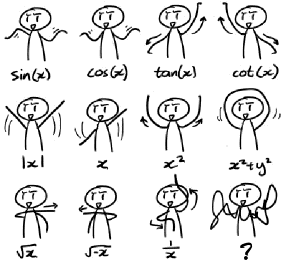- Ask class room to recall steep hills, or mountains, or slopes, that they've had experiences with & then just pick a number they think that represents the steepness of their hill
- Then explain slope
"The slope of a line is a number that represents the degree of steepness of the line."
- After explaining that, have students make a graph and draw lines on the graph with specified different degrees of steepness
"On your graph, start your pencil at the origin, (0,0) and plot a point here. Then, move your pencil to the right one unit and up k units. The k units should be your slope. So for example, if the mountain or the hill you picked had a slope of 7, move your pencil up 7 units. Then, connect the points and draw a line. Here, you have a line with a slope of k, and k>0. Now, make a line with a slope of 10, 5, and 15."
- After that, have students create a new graph & explain
"So what happens if on my new graph, I plot a point at the origin, (0,0) and then I move over three units to the right? And then I move three units up? If I connect these points and draw a line, what is my slope? For a line that isn't as easy as the first, you can use a formula:
rise
---------
---------
run
This formal basically is asking, 'how much did you rise from the origin point, and how far did you run?' In the case of the line we just created, we rose three units up from the origin, and we ran three units to the right, so that would make our formula
3
-----
3
Which equals one. The slope of this line is one. Now, on the same graph, start at the origin and move to the left four points. Plot a point there. And then move six points to the left and go down five. What would our formula be here? Well, we didn't rise here, we fell. But that's okay, it just means we have to figure out how much it fell. So since the first point's location is (-4, 0) and the second point's location is (2, -5) we can use this formula on it
yfinal - yoriginal
-----------------------
xfinal - xoriginal
This formula is the same as the rise over run formula because points along the x axis determine how much you are running, because running is something you do horizontally, while points along the y axis determine how much you are rising, because rising is something you do vertically. So in the case of the line we just made, the point (0, -4) would be our original and (2, -5) would be our final.So let's plug that in and see what we get
-5 - (-4)
----------
2 - 0
=
-9
-----
2
So here, our slope is negative 4.5, or -9/2. And now you know how to find the slope, or steepness in lines on a graph."







